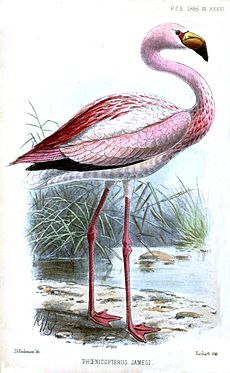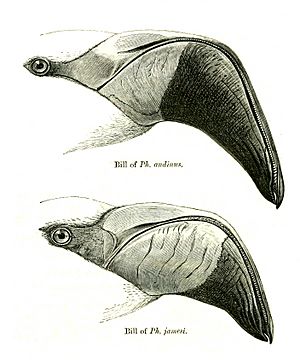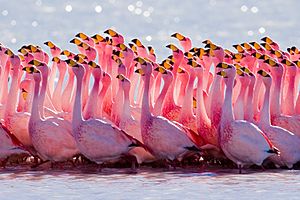James's flamingo facts for kids
Quick facts for kids James's flamingo |
|
|---|---|
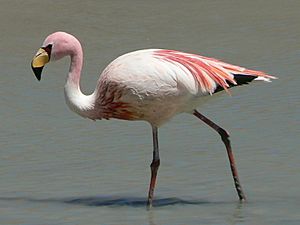 |
|
| Conservation status | |
| Scientific classification | |
| Genus: |
Phoenicoparrus
|
| Species: |
jamesi
|
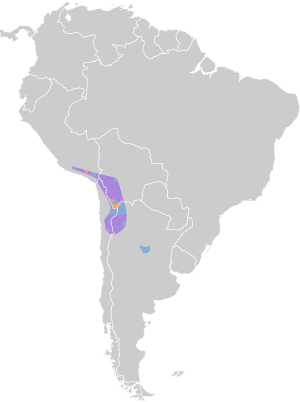 |
|
| Range map Non-Breeding Year-round Breeding | |
The James's flamingo (Phoenicoparrus jamesi), also called the puna flamingo, is a special type of flamingo. It lives high up in the Andean mountains. You can find it in Peru, Chile, Bolivia, and northwest Argentina.
This bird is named after Harry Berkeley James. He was a British naturalist who studied these amazing birds. The James's flamingo is very similar to the Andean flamingo. These two are the only members of their group, Phoenicoparrus. The Chilean flamingo, Andean flamingo, and James's flamingo all live in the same areas. They even share colonies and nesting spots. People once thought the James's flamingo was extinct. But a group of them was found in a faraway place in 1956!
Contents
About James's Flamingos
The James's flamingo is smaller than the Andean flamingo. It's about the same size as the lesser flamingo from other parts of the world. Charles Rahmer first collected a specimen of this bird. He was on an expedition for Harry Berkeley James. The bird was named after him.
These flamingos are usually about 90 to 92 centimeters (about 3 feet) long. They weigh around 2 kilograms (about 4.4 pounds). James's flamingos have a very long neck. It has 19 long bones called cervical vertebrae. This lets them move and turn their head a lot.
They also have long, thin legs. What looks like their knee in the middle of the leg is actually their ankle! Their real knee is hidden higher up. Their feathers are a very light pink. They have bright red streaks around their neck and on their back. When they are resting, you can see a little black on their wings. These are their "flight feathers."
Adult James's flamingos have bright red skin around their yellow eyes. Their legs are brick red. Their bills are bright yellow with a black tip.
James's flamingos look like other flamingos in South America. But the Chilean flamingo is pinker and has a longer bill that isn't yellow. The Andean flamingo is bigger. It has more black on its wings and bill, and yellow legs. The easiest way to tell James's flamingos apart is their lighter feathers. Also, look for the bright yellow on their bills.
You can also tell the two Phoenicoparrus flamingos apart by their feet. They have three toes but no back toe (called a hallux). Other flamingo species have three front-facing toes and a back toe.
Feathers and Color
When flamingo chicks are born, they are gray or white. Their feathers turn pink when they are about 2 or 3 years old. This happens because of their diet. They eat food rich in carotene, which is like the stuff that makes carrots orange. The chemicals that color their feathers are called terpenoids. These are alpha- and beta-carotenes.
An adult flamingo has 12 main feathers on each wing for flying. Their body is covered in contour feathers. These feathers protect the bird and help keep it dry. They have a special oil that helps with waterproofing. When flamingos rest, they face into the wind. This stops rain from blowing under their feathers and soaking them.
Their feathers are pale pink. They have bright red streaks around their necks and on their backs. When they are perched, you can see a small amount of black on their wings. These are the flight feathers. Flamingos usually have 12 to 16 tail feathers.
James's flamingos molt their wing and body feathers. This happens based on their breeding schedule. The color of their new feathers depends on what they eat. Male and female flamingos have the same feather colors.
How They Fly
All types of flamingos can fly. The flight feathers are easy to spot on James's flamingos. They are the only black feathers on the bird. To start flying, they run a few steps. Then they begin to flap their wings. When they want to land, they do the opposite. They run as they touch down. This helps them slow down and stop flapping their wings.
When migrating in a group, flamingos can fly very fast. They have been seen flying up to 60 kilometers per hour (about 37 miles per hour). But they might not fly this fast for shorter trips.
Flamingo Life
What James's Flamingos Eat
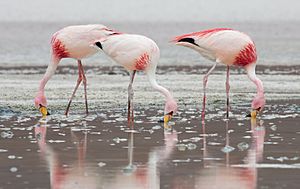
Both James's and Andean flamingos feed their chicks a special liquid. This liquid is made in their crop and brought up from their esophagus. Both male and female parents can feed the chick. Adult flamingos are amazing filter feeders. They filter tiny bits of food from the water.
The James's flamingo has the best filter-feeding system of all flamingos. It eats tiny diatoms and other very small algae. Its bill has a deep keel, which means it's shaped like a boat's bottom. To eat, flamingos walk into the water with their long legs. They bend their necks into an S-shape. This lets their bill go into the water. The S-shape helps them keep their head upright. It also lets them put the bill as shallow or deep as they want. Only the tip of the bill goes into the water. This keeps their nostrils above water.
Water full of tiny organisms flows into the bill. Then the filtering begins. The lakes where flamingos usually feed are mostly fresh water. But if they find salt water, flamingos have special salt glands in their nostrils. These glands get rid of extra salt.
The filtering starts with the tongue. It's very soft and has channels. These channels guide the food and water to the filtering parts. The bill of James's flamingo is the narrowest of its kind. Both Andean and James's flamingos have deep-keeled bills. Their upper jaw is narrower than the lower one. This means the opening of the bill is on the top side.
The bill of James's flamingo is smaller. Its upper jaw is narrower. The part of the bill closest to the head is mostly flat. Then it curves downward. The tip ends with a hook-like shape. The inside of the beak is like the lesser flamingo's. Both the upper and lower jaws have lamellae. These are tiny plates that filter the food.
The lamellae in the front part of the bill are like curved ridges. Towards the tip, they become more like hooks. James's flamingo has the most lamellae. This means they are very close together. There are about 21 lamellae per centimeter in this species. That's more than twice as many as in other flamingos! When the jaws close, the lamellae fit together tightly.
The diatoms they eat are about 21–60 micrometers in size. These tiny diatoms are usually found near the edge of the water. Even in groups with different flamingo species, James's flamingos usually feed closest to the water's edge. These birds can use their webbed feet to stir up tiny algae if there isn't enough floating in the water.
Reproduction and Life Cycle
Flamingos start their breeding cycles when they are about 6 years old. That's when they are fully grown. They don't breed every year. Sometimes they skip a year. The whole colony might do mating rituals at the same time.
Males show off by making sounds. They stick their necks and heads straight up. Then they turn their heads back and forth. Females start mating by walking away from the group. A male will follow her. The female then spreads her wings, and the male gets on her back.
The female lays one egg. The egg is laid on a cone-shaped nest. The nest is made from mud, sticks, and other things found nearby. The egg is oval, like a chicken egg. But it is smaller than the eggs of other flamingos, even the closely related Andean flamingo.
Both the male and female incubate the egg. They sit on it for 26 to 31 days. Then the chick hatches. The chick breaks through the shell using an egg tooth. This isn't a real tooth. It's a hard, pointy part that falls off after the chick hatches.
When newly hatched, the chick's bill is straight and red. Later, it gets its curve and the adult colors. Their feathers are white and gray. Their legs are pink. The eyes of chicks are gray for their first year. Parents can tell their chick apart from others in the colony. They recognize them by how they look and sound.
Protecting James's Flamingos
The IUCN decided in 2008 that this species is near threatened. This means their numbers have gone down over the last three generations.
The biggest danger to these flamingos is humans harming their habitat. In the past, people sometimes took eggs from nests to sell them. But now, rules are in place to stop this. Environmental problems like heavy rainfall can also affect their breeding. If there isn't enough food, like diatoms, that also threatens the species.
See also
 In Spanish: Parina chica para niños
In Spanish: Parina chica para niños
- Laguna Colorada



